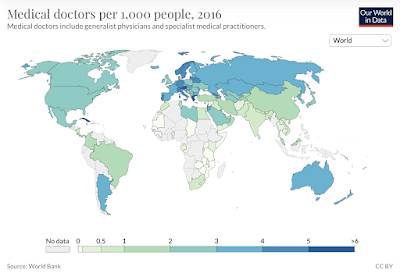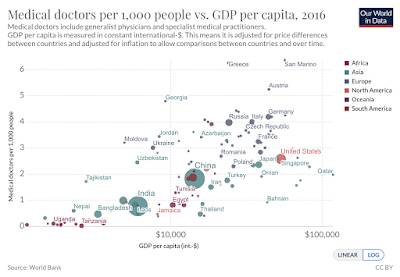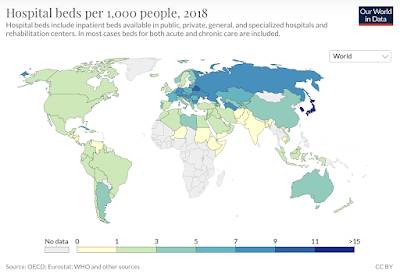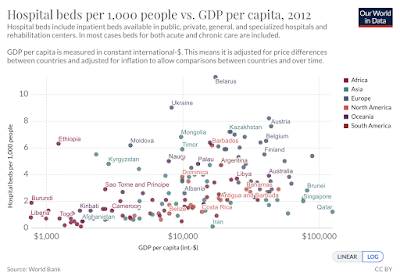Thanks to Our World in Data we have access to some of the more interesting global data which allows us to directly compare key components of healthcare data. This is particularly pertinent during the current pandemic; the nations with the best and most robust healthcare systems are the ones that have been able to provide the best medical services for their citizens.
Let's look at two key components of healthcare that provide us with an idea of the robustness of the healthcare systems around the world:
1.) Medical doctors per 1000 people (latest World Bank data for 2016 unless otherwise noted):
Here is the data for several nations :
Australia – 3.5 per 1000 (2015)
Canada – 2.54 per 1000 (2015)
China – 1.81 per 1000 (2015)
Germany – 4.19 per 1000 (2015)
India – 0.76 per 1000
Japan – 2.37 per 1000 (2014)
Russia – 3.98 per 1000 (2015)
Sweden – 4.19 per 1000 (2014)
United Kingdom – 2.83 per 1000
United States – 2.57 per 1000 (2014)
2.) Medical doctors per 1000 people vs. GDP per capita (latest World Bank data for 2016 unless otherwise noted):
Here is the data for several nations noting that GDP per capita is measured in constant international dollars meaning that it is adjusted for price differences between countries and adjusted for inflation to allow comparisons between nations:
Australia – 3.5 per 1000 (2015) per capita GDP $44,493
Canada – 2.54 per 1000 (2015) per capita GDP $43,238
China – 1.81 per 1000 (2015) per capita GDP $14,401
Germany – 4.19 per 1000 (2015) per capita GDP $44,432
India – 0.76 per 1000 per capita GDP $6,096
Japan – 2.37 per 1000 (2014) per capita GDP $38,283
Russia – 3.98 per 1000 (2015) per capita GDP $24,417
Sweden – 4.19 per 1000 (2014) per capita GDP $46,568
United Kingdom – 2.83 per 1000 per capita GDP $39,309
United States – 2.57 per 1000 (2014) per capita GDP $53,399
One would think that the world's most affluent nations would have more doctors per 1000 citizens, however, such is not always the case. As you can see, Russia's per capita GDP is less than half of the United States yet it has significantly more medical doctors per 1000 of its citizens. Australia and Canada have roughly the same per capita GDP, however, Australia has 1 additional medical doctor per 1000 people than Canada, a significant difference.
3.) Hospital beds per 1000 people (latest OECD and WHO data 2018 unless otherwise noted):
Here is the data for several nations:
Australia – 3.845 per 1000 (2016)
Canada – 2.5 per 1000
China – 4.34 per 1000 (2017)
Germany – 8.0 per 1000 (2017)
India – 0.53 per 1000 (2017)
Japan – 13.05 per 1000 (2017)
Russia – 8.05 per 1000 (2017)
Sweden – 2.22 per 1000 (2017)
United Kingdom – 2.54 per 1000 (2017)
United States – 2.77 per 1000 (2016)
4.) Hospital beds per 1000 people vs. GDP per capita (latest World Bank data for 2016 unless otherwise noted):
Here is the data for several nations:
Australia – 3.845 per 1000 (2016) per capita GDP $44,493
Canada – 2.5 per 1000 per capita GDP $43,238
China – 4.34 per 1000 (2017) per capita GDP $14,401
Germany – 8.0 per 1000 (2017) per capita GDP $44,432
India – 0.53 per 1000 (2017) per capita GDP $6,096
Japan – 13.05 per 1000 (2017) per capita GDP $38,283
Russia – 8.05 per 1000 (2017) per capita GDP $24,417
Sweden – 2.22 per 1000 (2017) per capita GDP $46,568
United Kingdom – 2.54 per 1000 (2017) per capita GDP $39,309
United States – 2.77 per 1000 (2016) per capita GDP $53,399
Once again, you can see that in this sampling of nations there is not a close relationship between the number of hospital beds and per capita GDP. In fact, Russia which has the third lowest per capita GDP on the above sampling of nations has the second highest number of hospital beds per 1000 people by a relatively wide margin.
While a high ratio of doctors and hospital beds to population does not always result in better healthcare, it does mean that, in general, citizens of nations with a low ratio of both cannot expect to receive the quality of care that those who live in better served nations have become accustomed to receiving.
Click HERE to read more from this author.
You can publish this article on your website as long as you provide a link back to this page.





Be the first to comment